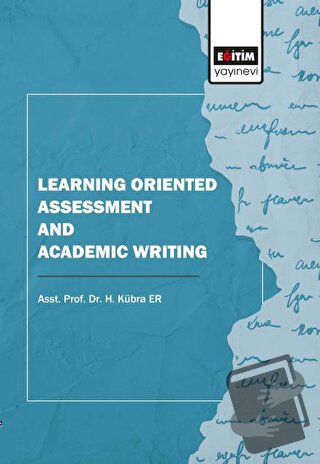
Academic writing has attracted attention and occupied a significant place in the field of ELT since academic writing helps students learn reasoning skills, communication, critical thinking, analytical thinking, research, and language skills. Similarly, LOA (Learning Oriented Assesment) has also started to gain popularity, recognition. Although there is a growing body of studies on academic writing and assessment in higher education, specifically LOA on academic writing, has received less attention. Besides, regarding negative aspects of the traditional type of assessments it is claimed that learner-oriented assessment is against the traditional type of assessment which is about assessments that consist of judgment-focused tasks, learner excluded assessment and judgment-focused feedback. Thus, traditional assessment practices may have some weaknesses and limitations such as underestimating learners’ capacities to evaluate their own work compared to LOA (Boud and Falchinov, 2006).
Therefore, it would be useful, beneficial, and effective for describing principles and stages, which are linked to patterns of LOA and connect these specifically to academic writing. In this manner, LOA can be considered paramount importance and should be definitely used to support and promote effective learning specifically in higher education. Thus, this book would hopefully be valuable and significant for a more efficient assessment of academic writing in higher education.
In brief, the current book would make several contributions to the field of applied linguistics in terms of ‘detailed description of LOA implementation process, in higher education, focusing specifically on academic writing.
| Taksit Sayısı | Taksit tutarı | Genel Toplam |
|---|---|---|
| Tek Çekim | 243,00 | 243,00 |
| 3 | 88,52 | 265,55 |
| 6 | 46,73 | 280,40 |
| 9 | 32,81 | 295,27 |
| 12 | 25,84 | 310,09 |
| Taksit Sayısı | Taksit tutarı | Genel Toplam |
|---|---|---|
| Tek Çekim | 243,00 | 243,00 |
| 3 | 88,52 | 265,55 |
| 6 | 46,73 | 280,40 |
| 9 | 32,81 | 295,27 |
| 12 | 25,84 | 310,09 |
| Taksit Sayısı | Taksit tutarı | Genel Toplam |
|---|---|---|
| Tek Çekim | 243,00 | 243,00 |
| 3 | 88,52 | 265,55 |
| 6 | 46,73 | 280,40 |
| 9 | 32,81 | 295,27 |
| 12 | 25,84 | 310,09 |
| Taksit Sayısı | Taksit tutarı | Genel Toplam |
|---|---|---|
| Tek Çekim | 243,00 | 243,00 |
| 3 | 88,52 | 265,55 |
| 6 | 46,73 | 280,40 |
| 9 | 32,81 | 295,27 |
| 12 | 25,84 | 310,09 |
| Taksit Sayısı | Taksit tutarı | Genel Toplam |
|---|---|---|
| Tek Çekim | 243,00 | 243,00 |
| 3 | 88,52 | 265,55 |
| 6 | 46,73 | 280,40 |
| 9 | 32,81 | 295,27 |
| 12 | 25,84 | 310,09 |
| Taksit Sayısı | Taksit tutarı | Genel Toplam |
|---|---|---|
| Tek Çekim | 243,00 | 243,00 |
| 3 | 88,52 | 265,55 |
| 6 | 46,73 | 280,40 |
| 9 | 32,81 | 295,27 |
| 12 | 25,84 | 310,09 |
| Taksit Sayısı | Taksit tutarı | Genel Toplam |
|---|---|---|
| Tek Çekim | 243,00 | 243,00 |
| 3 | - | - |
| 6 | - | - |
| 9 | - | - |
| 12 | - | - |
Academic writing has attracted attention and occupied a significant place in the field of ELT since academic writing helps students learn reasoning skills, communication, critical thinking, analytical thinking, research, and language skills. Similarly, LOA (Learning Oriented Assesment) has also started to gain popularity, recognition. Although there is a growing body of studies on academic writing and assessment in higher education, specifically LOA on academic writing, has received less attention. Besides, regarding negative aspects of the traditional type of assessments it is claimed that learner-oriented assessment is against the traditional type of assessment which is about assessments that consist of judgment-focused tasks, learner excluded assessment and judgment-focused feedback. Thus, traditional assessment practices may have some weaknesses and limitations such as underestimating learners’ capacities to evaluate their own work compared to LOA (Boud and Falchinov, 2006).
Therefore, it would be useful, beneficial, and effective for describing principles and stages, which are linked to patterns of LOA and connect these specifically to academic writing. In this manner, LOA can be considered paramount importance and should be definitely used to support and promote effective learning specifically in higher education. Thus, this book would hopefully be valuable and significant for a more efficient assessment of academic writing in higher education.
In brief, the current book would make several contributions to the field of applied linguistics in terms of ‘detailed description of LOA implementation process, in higher education, focusing specifically on academic writing.










